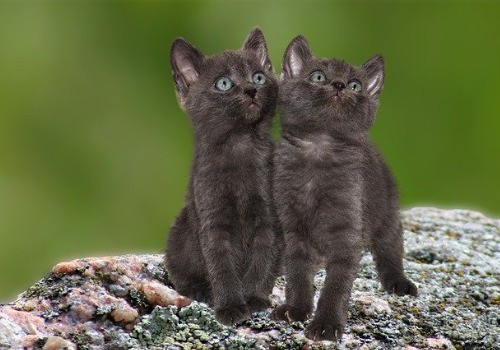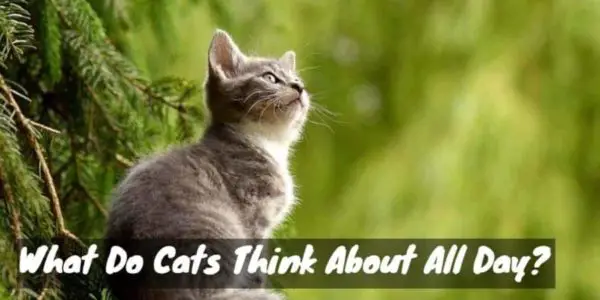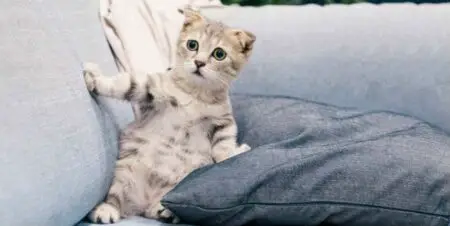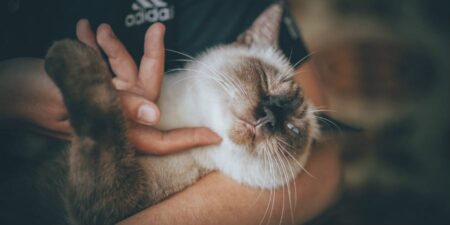Ever wondered what mysteries unfold within the quiet, contemplative gaze of your feline friend? As humans, our days tend to be busy, with no shortage of things to do. Even during our idle times, we have plenty of thoughts to occupy our minds. How our friends and families are doing, what’s going to happen on our favorite TV shows, the meaning of the universe, and the list goes on and on.
In contrast, cats may seem like they don’t have a lot going on. When they’re not asleep, they’re usually licking themselves, eating, or staring off into space. They don’t know about world issues or the latest media, and they don’t really have any responsibilities; the charmed life of a cat leaves it with seemingly little to think about.
What exactly goes on in the mind of a cat all day? Is it as blank as it sometimes seems, or is there more to cat cognition than first meets the eye? Let’s examine how cats think and discover what things occupy their thoughts.
The Confounding Cat: Mysteries of the Feline Mind
A Brief History

Domestic cats and dogs are the two most common species we keep as pets, but of the two, dogs usually seem easier to understand. For the most part, dogs are more openly communicative with humans, more trainable, and less independent than cats. There’s a reason for this, and it begins tens of thousands of years ago.
Humans began domesticating dogs long before cats. The earliest proven example of this is a set of domestic dog remains buried alongside humans, dated over 14,500 years old. Fossils from over 36,000 years ago indicate that domestic dogs may have existed even further back, though this has not been definitively proven.
Either way, humans domesticated dogs before the invention of agriculture, so we’ve had a long time to get to know each other. Selective breeding over these thousands of years of companionship has resulted in dogs bred to be our friends. With such a deep bond spanning thousands of generations, it’s no wonder our two species understand each other so well.
Cats, on the other hand, are a relatively new presence in our lives. According to archaeological evidence, we may have begun taming wild cats around 9,500 years ago, but a tamed wild cat is still a far cry from domestic. For thousands of years, humans simply allowed wild cats to live amicably alongside them, using them as rodent control but not pursuing further companionship.
Around 1200 BC, this began to change. More and more people started viewing cats as pets, developing emotional attachments to them, and forming bonds with them, especially in Egypt. Pet cats were brought from Egypt to Greece, and from there, they spread to the rest of Europe, arriving in Germany by 500 BC.
By this point, cats had already evolved to look and behave very similar to the domestic cats we know and love today; unlike dogs, they weren’t selectively bred for human companionship. The trait of sociability towards humans emerged on its own, likely because friendlier cats were better able to coexist with humans as pest control. They took advantage of the plentiful food and shelter in human settlements to live longer lives and reproduce more, so over time, tameness became a predominant trait.
Wild at Heart
Genetically speaking, the modern domestic cat barely differs from its wild counterparts; in fact, wild cats and domestic cats can successfully breed with each other. This wild streak is part of why we have more difficulty understanding them than we do with dogs. We’re the ones who made dogs the way they are, whereas cats made themselves.
Because we’ve had such an extensive influence in shaping dog behavior, we intuitively know a lot more about how they think and act – we’ve bred dogs to be more understandable, which means we’ve bred them to be more like us. Cats remain independent and thus mysterious.
Areas of Interest
Scientific advances within the past hundred years have opened up a new opportunity to understand cats. We now know far more about the brain, with neuroscience explaining its physical properties and psychology exploring its intangible functions. With the help of computers and other new machines, scientists are able to study the feline mind and make incredible discoveries that explain how cats think — and, to an extent, what they think about.
The Cogs of Cognition: How Cats Think
We’ve yet to completely unravel the mysteries of the human mind, let alone the feline mind, but we still know quite a bit about how cats think and feel. By utilizing brain imaging technologies and applying concepts from human psychology, we’ve been able to add more and more details to the big picture of cat cognition.
Emotions
Describing emotions can be tough even for the most self-aware humans. Cats can’t speak our languages, so we know even less about their feelings and how they experience them. But we do know that they feel many of the same emotions that we do, and though they express them quite differently, they seem to feel them just as strongly.
Emotions can be thought of as responses to sensory stimuli. Sounds, sights, smells, tastes, and touches deliver information about the cat’s surroundings. The information is processed with the help of instincts and memories, which instill one or more emotions – combinations of physiological effects and mental activity that tell the cat how to react to the stimuli.
Cats display happiness in calm, understated ways: they relax, stretch out, close their eyes, and purr. This is because comfort is such a big part of their happiness. When something excites a cat, such as the sound of food being prepared or its favorite person arriving home, its behavior becomes more lively; an excited cat will vocalize, jog, or run around and rub against its owner (a cat’s version of a hug!)
Angry cats will fluff up, arch their backs and push their ears back while hissing or growling. Fear can look similar, though a fearful cat may display more avoidant behavior, such as hiding or trying to escape. After experiencing such a mood, they require a cool-down period as we do — some quiet time to process the incident and calm down.
Cats do seem to feel sadness, though they can hide it quite well. Similar to human depression, sadness in cats manifests largely in altered long-term behaviors, such as a decreased appetite and loss of interest in playing or socializing.
There are more complex emotions that we feel (such as worry, shame, and love) that are less understood, often combining multiple base emotions and involving many areas of the brain. We don’t know for sure if cats feel these “higher” emotions, but many people believe that they do at least feel love. This seems to be supported by the immense affection cats show toward us, even when they don’t need anything.
Communication

Without understanding how cats communicate with each other and with humans, it’s impossible to understand how they think. Cats communicate largely through body language and facial expressions but also use many vocalizations tailored to various situations and conversation partners. We may not be able to directly translate what they say, but we can get the gist of it, and maybe someday we’ll be able to compile a full feline dictionary.
Although it’s often said that cats perceive and treat humans simply as large, weird-looking cats (which is true to an extent) they communicate with humans much differently than with other cats. Meows are reserved for use with people, usually as a demand for food or attention. They’re one of the best indicators of what a cat is thinking about. If a cat meows, it’s thinking about what you can do for it.
On the other hand, much of cat-to-cat communication goes unspoken, conveyed through movement rather than speech. There are exceptions to the human-cat communication divide: aggression is always shown by biting, clawing, yowling, and hissing. And affection, regardless of the species of its recipient, is shown by rubbing, grooming, and purring.
Mind Reading: What Cats Think About

Maybe someday we’ll be able to see the world through a cat’s eyes, perceiving and processing stimuli the same way it does, feeling the same drives and desires. Until that day, we can only make educated guesses about what cats think.
We can get little glimpses into cats’ inner worlds and recurring thoughts through analysis of their communication and behavior. Here are some of the things your cat probably thinks about – maybe next time you catch it staring at nothing, it’s actually got one of these on its mind.
Food
If behavior is any indication, cats think about food all the time. The thought of a delicious meal seems to pop up at even the slightest provocation, from the sight of you entering the same room as its food bowl to anything that sounds vaguely like a can being opened. When it does, you’ll know by the pitter-patter of paws racing down the hall and the endless stream of needy meows.
As such a critical component of survival, it’s no wonder that food is constantly on a cat’s mind. In the wild, every decision must be taken into account with the next meal, or else there’s a risk of starvation. Your cat’s instinctual drive to eat at every opportunity remains strong, so go easy on it when the begging starts – it can’t be helped!
The Past
Cats have very strong memories, particularly their long-term memories. With such heightened senses of smell, sight, and hearing, they’re able to record extremely detailed mental images of their experiences. Years later, they’re still able to recall people, places, and things from their pasts with incredible accuracy, exhibiting the same emotions they did the first time around.

It’s possible that when a cat spaces out, staring at the wall or out a window at nothing for minutes or even hours, it replays memories of its past. We do the same thing, especially when we’re bored or reminded of a little detail from one of our memories. Perhaps the sound of a certain passing car makes your cat remember hearing a similar car years before, which then makes it remember its favorite toy from that time, and before long, it’s lost down memory lane.
We know that sleep plays a big role in encoding memories, and some scientists believe that dreams are at least partially comprised of bits and pieces from various memories, some old and some newly formed. Cats probably don’t dream as much as us (their periods of REM sleep last just a few minutes a day), but when they do, perhaps they’re also exercising their memories. Your cat’s slumber may just be when it does its most abstract and complex thinking – so take care not to wake it!
You
If you’ve ever arrived home to find your cat already waiting by the door, ready to rub on your legs and beg for a petting, you know that you were on its mind. But the extent to which this is true may surprise you. Many behaviorists theorize that housecats exist in perpetual kittenhood, perceiving their owners as their mothers, and they behave accordingly.
Children tend to think of their mothers all the time – when they find something interesting, they want to show Mom, and when they need something, Mom will know how to help. Kittens seem to treat their mothers the same way… and adult cat behavior indicates that your cat also treats you that way.
That’s why your cat comes to get you when it sees something weird out the window and insists on bringing you mice and birds that it catches. You’re always in the back of your cat’s mind to provide help, support, and company. Sometimes cats display their gratitude and affection in strange ways, but the core message is that you’re important and in their thoughts.
"In ancient times cats were worshipped as gods; they have not forgotten this."
-- Terry Pratchett






I like this article